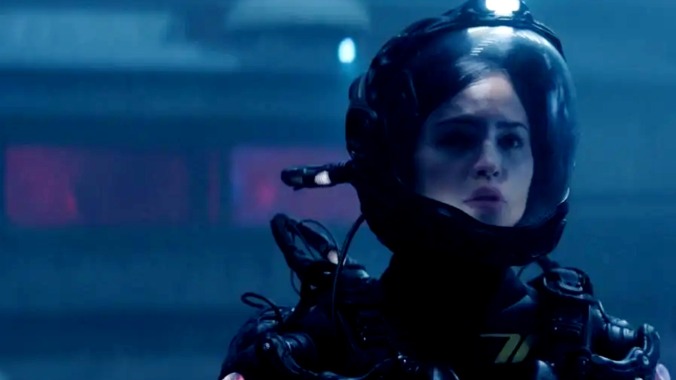‘Ash’ Is an Ayahuasca Trip Through a Space Mission From Hell
The sci-fi psychological horror movie is a living, breathing masterpiece—which isn't to say that it's not also one of the most stomach-churning films I've ever seen.
Photo: RLJE Films EntertainmentMovies
This post contains spoilers–in fact, is almost exclusively spoilers—for the movie Ash.
AUSTIN, Texas—When I walked into the Paramount Theater in Austin, Texas, on Tuesday night, I felt pretty chill. I was walking into a venue I love in a city I love on a gorgeous 70-degree night; the stars were in the sky; each of my hands had five fingers; and even though my plastic cup of rose was $20, it was crisp and refreshing. I understood the world and understood my place in it. Then I watched the experimental, mind-boggling movie Ash.
I’ve never taken ayahuasca, but from the many, many accounts I’ve read of the hallucinogenic drug over the years, I’m pretty sure it’s the same experience as watching Ash, the new sci-fi psychological horror about a murdered space crew on an alien planet from the producer Flying Lotus. (It premiered at SXSW and hits movie theaters later nationwide later this month.) The actual story is almost second to the stunning, neon visuals of Kepler-442b, which is based on an actual exo-planet of the same name about 1,200 lightyears from Earth. FlyLo (who also composed the film’s haunting soundtrack) crafted a living, breathing masterpiece—which isn’t to say that it’s not also one of the most stomach-churning films I’ve ever seen.
Ash stars Eiza González as Riya, an astronaut who wakes up on the floor of her room inside a station on Kepler, where she and a crew of five have been doing research for an undisclosed amount of time. Riya’s injured and the station’s in disarray, with the computer system repeatedly announcing that an unusual life form has been detected. As Riya slowly explores the situation, she realizes her memories are gone; she doesn’t know who she is, or why she’s there, and at one point says, “I don’t remember Earth” (which honestly sounds nice). Meanwhile, she’s also discovering the rest of the crew has been brutally murdered, except for one, Brion (Aaron Paul). He’s returned to the station from a patrol, he says, because he received a distress call. Suspicious! As they work to piece together what happened (despite Riya’s reservations about who Brion is and whether he’s dangerous), the oxygen levels in the station start to drop.
-

-

-

-

-

-

-

-

-

-

-

-

-

-

-

-

-

-

-

-

-

-

-

-

-

-

-

-

-

-

-

-

-

-

-

-

-

-

-

-








































